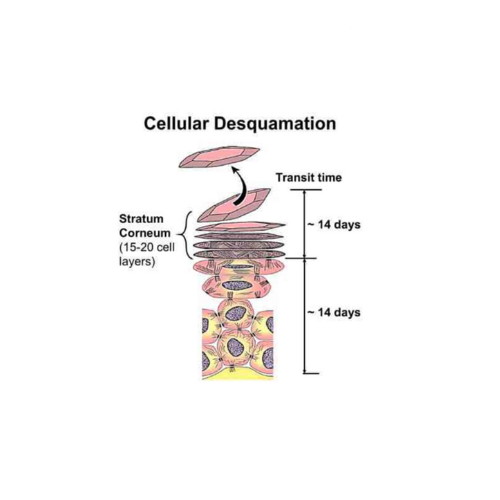
Human skin is a living organ and in order to keep it working in peak performance or more importantly looking as youthful as possible, we need to keep it healthy and understand the complexity of how skin is produced in a constant cycle which slows as we age.
The skin naturally exfoliates itself in a process called desquamation. The natural skin cell cycle moves through the outermost layer of our skin know as the epidermis in 4 or 5 defined layers, the epidermis is our protective covering of the body but is no thicker than a sheet of paper.
Our living skin cells are produced in the deepest layer of the epidermis known as the Basal Layer by cell division which consistently pushes the cycle upwards and it is also here where the production of pigment occurs by the melanocytes to protect our skins DNA from UV rays.
These skin cells then migrate up through the epidermis to the next defined layer known as the Spinous Layer, the layer takes this name due the spiny or prickle-like appearance of the desmosomes, the connective glue between the skin cells keeping them compact and held together, much like grout on a brick wall. In this stage of the cycle Langerhans cells are also present which assist in the skins immune function.
The next layer the cells move up to is the Granular layer, which is where the cells begin to die, where the nucleus of the cell begins to disperse and gives the appearance of distinct granules within it, if you were looking through microscope of course. The cells also begin to flatten and become more compact beginning to create the skin barrier.
At this stage of the skin cycle, the skin on the palms of our hands and soles of our feet go through an extra layer called the Clear layer. This is only present in these areas of thicker skin on the body and is an extra barrier formation composed of completely transparent cells through which light can pass.
Then the final layer, the Cornified Layer which we touch and feel being the outermost layer of the epidermis. It is composed of tightly packed, completely dead skin cells which are constantly being shed and then replaced by the cycle continuing.
This layer contains our skins Natural Moisturising Factor (NMF) a specific cocktail of multiple ingredients to maintain hydration. If the NMF decreases then we can lose water from the skin by evaporation out to the atmosphere causing dryness and inflammation to occur, this process is known as Trans-epidermal Water Loss (TEWL). The protein of keratin and the lipid bilayer around our skin cells help with this too and keeps the skin waterproof by acting like an occlusive to prevent water evaporation.
A small amount of TEWL is always taking place within the cornified layer and is actually important for the skin’s health. If the epidermis is compromised with over exfoliation, the incorrect products for your skin types or concerns or even from illness then TEWL can increase and may result in sensitivity.
